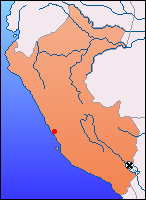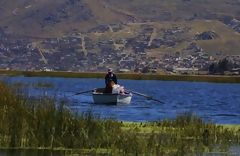 |
Related pages: |
 Lake Titicaca is the largest lake in the world situated above 2,000 meters, and the highest navigable lake, sitting at an altitude of 3,808 meters above sea level. It stretches 194 kilometers in length and 65 kilometers in width, covering a total area of 8,710 km², with 5,260 km² in Peru and 3,450 km² in Bolivia. Its maximum depth reaches 281 meters, making it hard to imagine that crossing the lake by boat can take more than a full day.
Lake Titicaca is the largest lake in the world situated above 2,000 meters, and the highest navigable lake, sitting at an altitude of 3,808 meters above sea level. It stretches 194 kilometers in length and 65 kilometers in width, covering a total area of 8,710 km², with 5,260 km² in Peru and 3,450 km² in Bolivia. Its maximum depth reaches 281 meters, making it hard to imagine that crossing the lake by boat can take more than a full day.
At this altitude, the air is exceptionally pure, giving the lake remarkable clarity. The water's transparency can reach up to 65 meters in depth on clear days, though the average visibility is around 15 meters. The surrounding mountains, which seem close, are actually 20 to 30 kilometers away, creating an optical illusion due to the unique quality of light in the region.
 Lake Titicaca is home to a rich array of wildlife, including several species of ducks and fish such as the suche, capache, and trout. Alpacas and llamas, iconic animals of The Andes, can also be seen along the shores and islands of the lake. The flora is dominated by reeds, which are used not only as food but also as building materials for traditional houses, canoes, and the floating islands that dot the lake.
Lake Titicaca is home to a rich array of wildlife, including several species of ducks and fish such as the suche, capache, and trout. Alpacas and llamas, iconic animals of The Andes, can also be seen along the shores and islands of the lake. The flora is dominated by reeds, which are used not only as food but also as building materials for traditional houses, canoes, and the floating islands that dot the lake.
One of the most unique features of Lake Titicaca is the presence of the Uros people, who live on floating islands made entirely of reeds, known as "totora". The Uros are descendants of one of the oldest civilizations in the Americas, and their traditional way of life has been preserved for centuries. The islands are built by layering reeds on top of each other, and the Uros navigate the lake in canoes also made from this natural material.
The climate in the Lake Titicaca region is typically dry and cool, with daytime temperatures reaching up to 20°C and dropping to 0°C at night. The rainy season lasts from December to April, with an average annual precipitation of 728 mm. Despite the harsh conditions, the lake remains a vital source of life and sustenance for the local communities, thanks to its abundant natural resources.
Lake Titicaca is not only a natural wonder but also deeply rooted in the history and mythology of pre-Columbian civilizations. According to Inca legend, the god Viracocha brought forth Manco Cápac and Mama Ocllo from the lake’s waters to found the Inca Empire. The lake, considered sacred, remains a place of pilgrimage and cultural significance for the Andean communities, who see it as a symbol of fertility and renewal.
Lake Titicaca is a top destination for nature lovers, history buffs, and travelers seeking unique cultural experiences. Boating on the peaceful waters of the lake, visiting the floating islands of the Uros, or exploring the islands of Taquile and Amantani are unforgettable experiences that offer a fascinating glimpse into traditional Andean life. This mythical lake, shared between Peru and Bolivia, continues to inspire and amaze all who visit it.